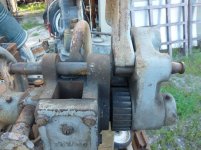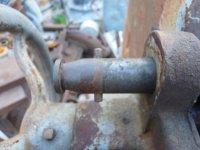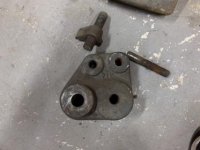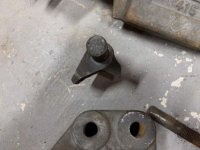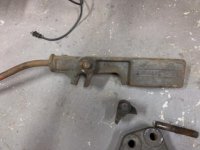I did some investigation and think I gave you some bad info from my faulty grey matter earlier.
The pin that I have which performs the ratcheting function...6" OAL x 1" dia. It slides into the quadrant from the RIGHT.


The pin that slides from the LEFT, in order to engage both loops, should be 10" OAL in my opinion. This is the one that engages the compound mode. The 6" pin above would be pulled out and the hole in the quadrant would be empty.

Of those 10", it takes 2" of axial travel to engage the counterweighted press arm. So I looked at two areas,
The space between the loops is 2-1/2" so that would allow a little pin to be screwed into the arm from the side as a small handle. 1/4" dia would just work.

And at 2" of retraction I looked to make sure it wouldn't clip your hands as you turn the handwheel. Looks good to me.

Couple of other issues. Someone mentioned the pins have to be uber-hard...I don't think it matters, both Right and Left pins are just cantilevered when they are under load, so its just a problem of bending stiffness where hardness does not help a bit.
Its also possible that my idea to screw in a little 1/4" handle into the center of the 2-1/2" wide pocket will weaken it because it takes some away from the cross-section. I can't say whether Dake does it that way, you could probably get an idea if you studied the online manual's exploded view illustration.
Last,
get that thing off casters !!! The ~1200# on wheels is waiting to send you to the ER or worse. Imo if you need to make the press portable, build a pallet base out of common 2x4s and get yourself a pallet jack. Then you can roll it all over when needed and it will still sit solidly without fear. See also: GRK-RSS structural screws for building strong wood structures.




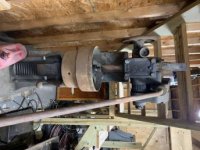


 awaiting me to get everything into the new shop space.
awaiting me to get everything into the new shop space.

